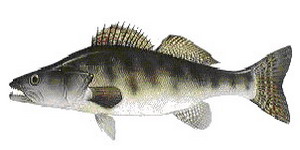

|

21 lbs |
05 oz |
09 drams |
09 kilos |
667 grams |
Year 2007 |
Distribution: Although zander are a relative newcomer to the British Isles, having been introduced to the Great Ouse Relief Channel in Cambridgeshire during the latter half of the last century, zander are spreading rapidly. Unlike many other species of fish that have been introduced by man, the conditions in the UK appear to favour the zander and, in particular, they seem able to spawn in a wide range of British waters. This has led to the zander spreading rapidly through the inter-linked Fen river system, into the midlands canal network and into the River Severn catchment. Despite this rapid spread, in most fisheries zander do not appear to represent a major threat to fisheries. Whilst zander numbers initially increase rapidly within 2-3 generations the fish become self-regulating as the larger fish predate heavily on the small fish. Populations stabilise at a low level and once again level out. The exception to this pattern is in heavily coloured water, such as busy canals. Here zander are a very effective predator and populations tend to be much higher having a negative impact on the populations of small silver fish, such as roach and gudgeon.
Features: Once commonly known as the pike-perch, this is actually a very apt name for the zander as they do resemble a cross between these two species. Nevertheless, zander are not related to these species, but share a niche between them. Zander have a pointed head with a large mouth, similar to a pike, with a pair of large gripping teeth in both the upper and lower jaws. Behind these are rows of smaller teeth that give the zander a rather ferocious look. The zander has the rough feel and spiked dorsal fins of the perch, protecting small fish from predation, particularly from pike and herons. The zander has a very large eye, perfect for hunting in murky water and under low light conditions that hints towards it's favoured hunting strategy.
Diet: Zander mouths have a smaller gape than pike, so although large fish are almost exclusively piscivorous, they take much smaller prey than a pike of similar size. Favoured prey are roach and gudgeon of between one and four ounces. These slim bodied fish are easy for the zander to handle and are also the dominant fish species in their favoured environments.
Spawning: Zander spawn during March and April forming loose aggregations around suitable habitat. Zander tend to spawn on submerged tree stumps, branches and reeds, although it is suspected that they can also spawn on plants and even canal pilings.
Growth: Zander are a relatively fast growing species and appear quite short lived. Fish can make ten pounds in under a decade as they have a high protein fish diet. The growth of zander varies greatly from water to water. In the canals, where the fish feed on small prey and spawn frequently, the average fish weighs only a couple of pounds. This is an ideal strategy to make use of the abundant small prey. In less suitable environments the zander spawn less frequently, use more energy for growth and so eventually grow much larger. Stillwaters seem particularly suitable for growing outsized zander, although most captures are accidental.
When you have purchased or caught your baits whether Live or Dead there are a few things you should know to keep them in tip, top condition. I will start with Livebaits.
Livebaits should be kept in the following ideal conditions, plenty of oxygenating water and preferably not more than 50 in a single tank. Do not feed them particularly if you do not have sufficient filtration as the build up of toxic water will occur, also do not handle them until you are ready to take some fishing. 20% of the water should be changed twice weekly to refresh but no more than this. Here is my set-up at home for keeping livebaits. No scimping on money here as this Livebait tank set up in my shed caters for everything as there is a drain behind the wall to drain off water and re-fresh, a filter system is incorporated with a pump for re-circulating the water and also a pump for oxygen, you can't beat fresh baits. There are 3 compartments, one on the left and one on the right for keeping baits, and the centre compartment is the filtration and oxygen set up.
When fishing overnight on those weekend sessions what I will do is lay one of these bait traps out with some bread inside and in the morning there are usually some baits caught.
Deadbaits have proved to be the number one Pike and Zander bait over the years for the biggest captures, although there are occasions when livebaits do have the edge - particularly where there is a high-pressure system looming. river fish, especially Roach and Eel sections, are the best deadbaits for Pike and Zander although the Lamprey is close behind over the past couple of years. Zander usually ignore sea baits such as mackerel, herring and sardines, although smelt do pick up a few fish. Zander prefer deadbaits that are around 4-6 inch long, and fished hard on the bottom.
Always puncture the swim bladder of your deadbait to ensure it sinks, fresh and frozen baits are equally effective. Livebaits should be on the small side 6oz is big enough for a specimen Zander, livebaits can be presented off the bottom, what we say is the pop up method 1-2ft is ideal. Place your baits as close as you can to any underwater structure if they exist, because fish feel more safe in these areas and will be more likely to feed confidently. Places to especially look for include sunken snags, depth variations, sunken reeds, and weed beds. these areas will help to pick up any patrolling zander using the feature as a point of ambush. Bear in mind though that tackle may need to be stronger in both the Line breakage and trace wire used, when you get a take you may have to bully the fish away from these structures. The drop-offs on most Gravel Pits, Reservoirs and Fenland drains from shallow to deep water are another particularly good area to concentrate on.
Leapfrogging your rods along the bank is often a sure-fire method of locating Pike and Zander, but as usual in fishing nothing is guaranteed. Try to find swims with indications of shoals of small prey fish, i.e., bubbling or activity of the surface and stick with them, pike and zander will not be too far away, usually you will locate them on the outskirts of these shoals and not in amongst them.
A few of the best baits to stick with and remember to keep them fresh as possible.
Eel sections 6 inch are a deadly bait particularly for Zander, try to keep bait size above 4 inch. An excellent slimy covered bait, great for casting long distances as they rarely come off the hook, they need to be hooked carefully preferably just nicked inside the skin so the hooks depart on the strike.
Half Mackerel baits are another excellent casting bait, plenty of oil escapes once in the water, my method is putting small slits along both sides of the bait prior to casting. Ensure one of the treble hooks is in the tail root if using tails. Both the heads and tails are good, I purchase mine whole in a crate of 40 from Billingsgate market in London, at a cost of £12. Tackle shops in my view are far too costly charging about £3.50 for two. Another substitute for the big baits are what we call the Joey or Horse Mackerel, which is just a smaller bait but can be hard to obtain.
Roach or Rudd are a natural bait for both Pike and Zander and probably account for most caught fish, size again about 6 inch are best. It's important that these baits are as fresh as possible as they can quickly go off.
Sandeels have taken fish on most venues, although I do not use them much but that's not to say they are ineffective, it is an under rated bait but very good on the fen drains. Try to purchase the larger type about 8 inch in length. My method using these is to air inject them with a couple of swan shot just up the trace so they are popped up off the bottom.
Sardines are probably the most oily bait that I use and for this reason tend to make sure I have a few when going on a fishing trip. They require a bit of care in the hooking and casting procedure as they quickly become very soft and are easily cast off the hook. I tend to use from frozen with one of the treble hooks through both lips to gain a good hold.
Smelts are a deadly bait for Pike in particular, I put it down to the cucumber smell that they give off, again a soft bait so hooking needs attention.
Spratts are an excellent, cheap bait and have accounted for three of my 20 pound Pike that I have caught, hooking method that has worked best for me is one treble mid-flank with the second hook in the tail.
Frozen packs of Mackerel are undoubtedly one of the best baits to use for deadbait wobbling as they do not break up on the cast. Do not neglect the naturals though, like Roach, Chub and Rudd.
My baits are mostly bought at Billingsgate fish market as it is on my way home from work and alot cheaper to buy, for instance a crate of Herring / Mackeral /Sardines or Spratts cost about £12 and you roughly get 40 Herring or Mackeral, 70 Sardines or about 400 Spratts. The worst bit I hate although essential is wrapping them in cling-film to prevent frostbite in the freezer.
There are a number of other good baits and none should be neglected, here are a few to try out. Trout, Herrings, Lamprey and small Jack Pike.
©Norfolk Fishing Network 2004 - 2026®All Rights Reserved.